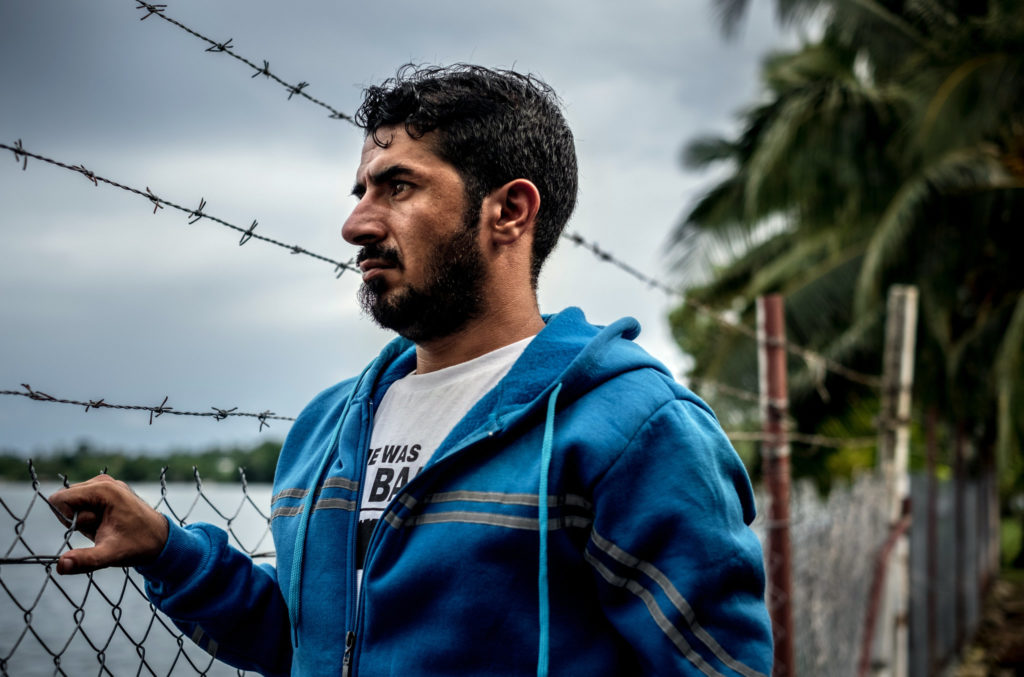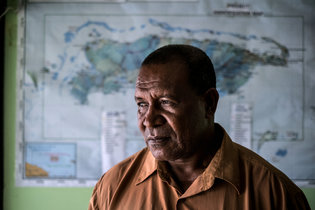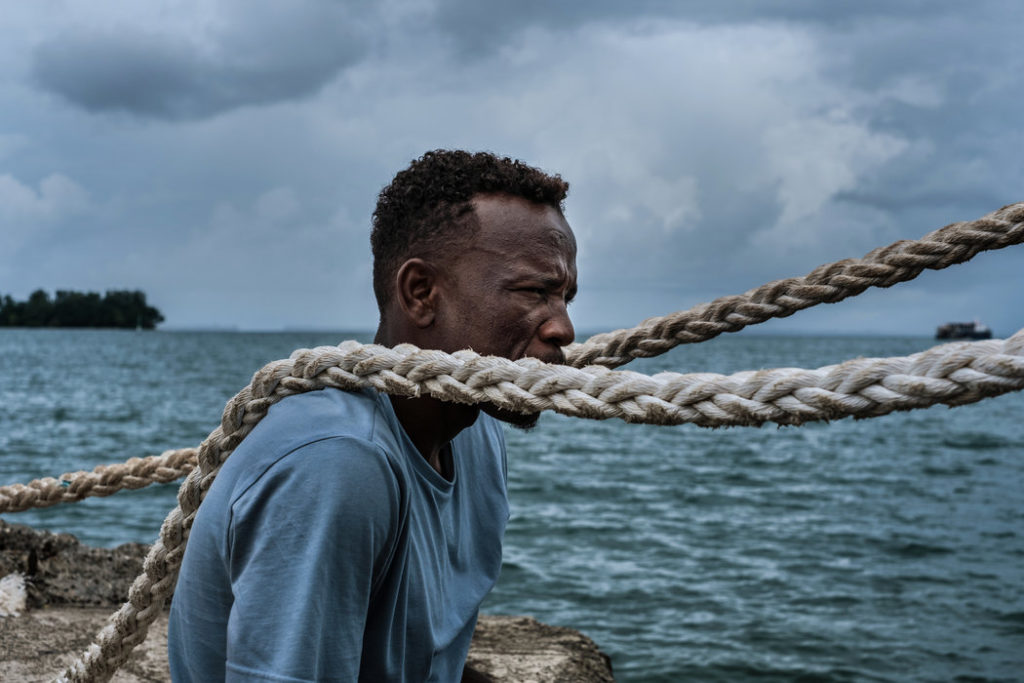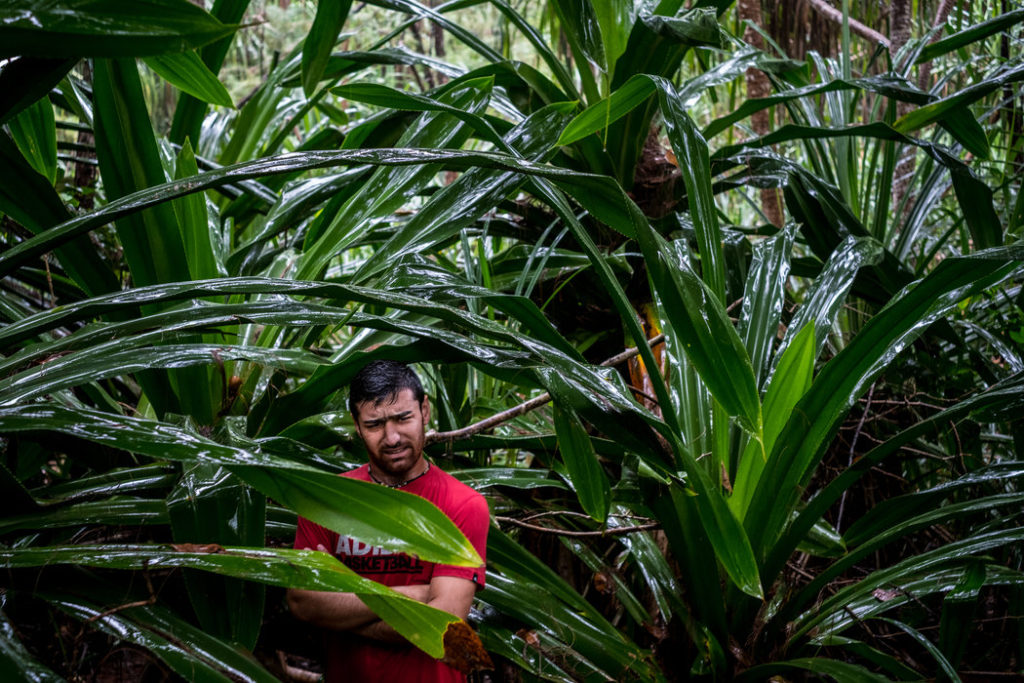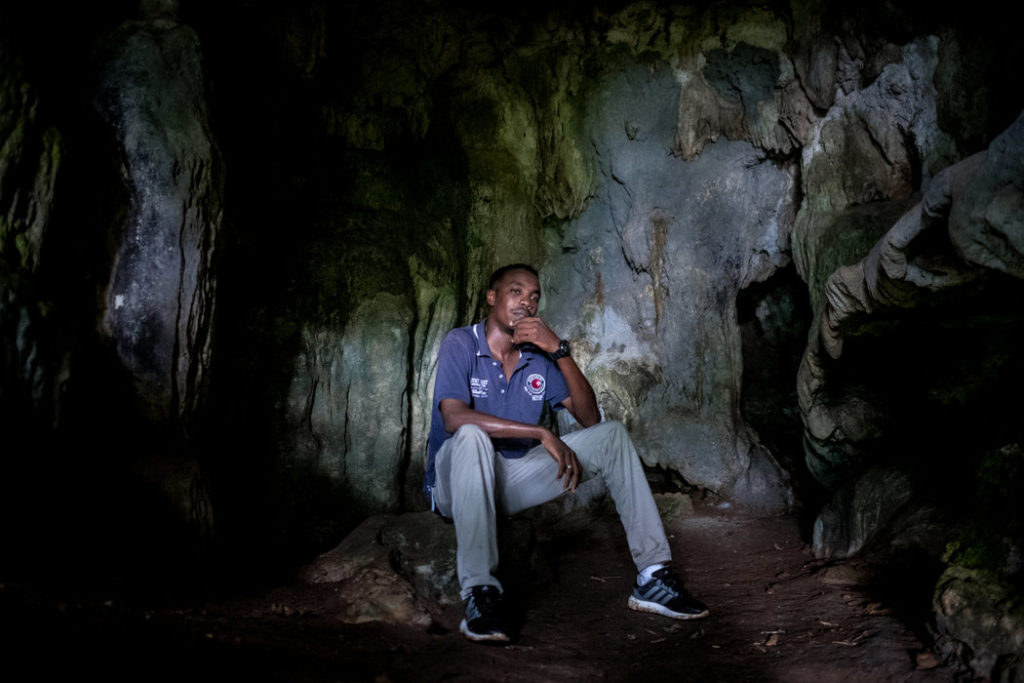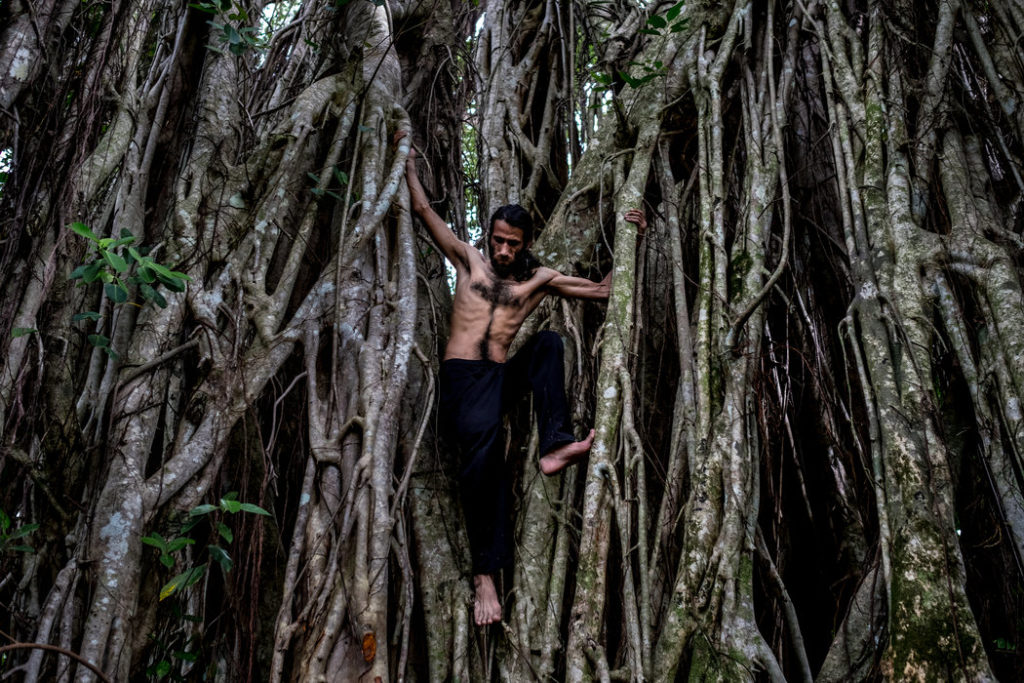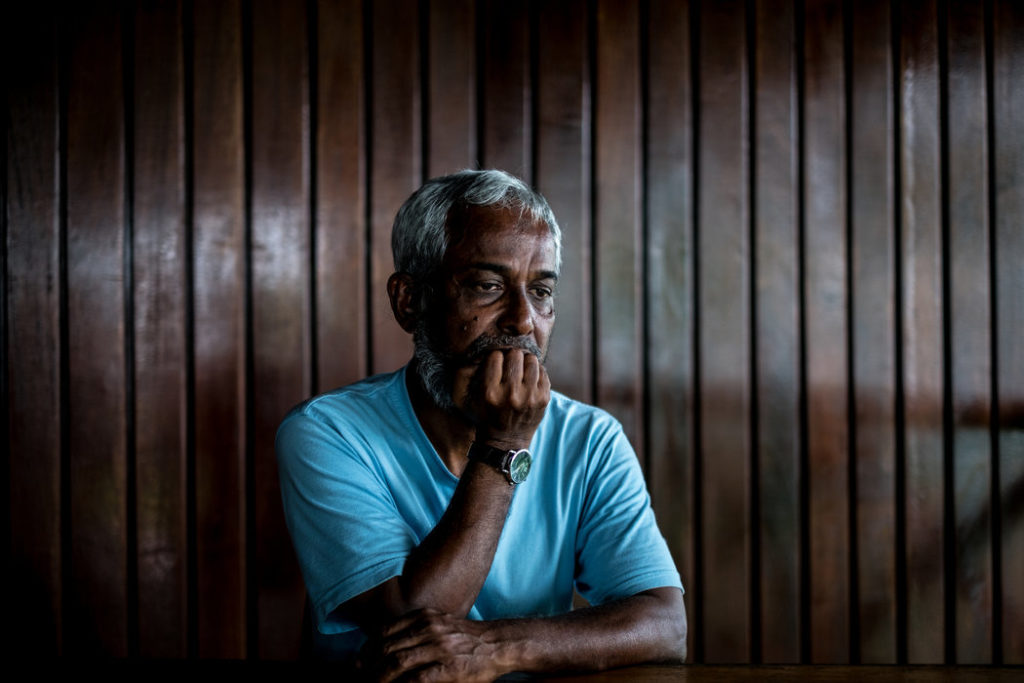Broken Men in Paradise
ASIA--PACIFIC, 12 Dec 2016
Roger Cohen – The New York Times
The world’s refugee crisis knows no more sinister exercise in cruelty than Australia’s island prisons.
9 Dec 2016, Manus, Papua New Guinea — The plane banks over the dense tropical forest of Manus Island, little touched, it seems, by human hand. South Pacific waters lap onto deserted beaches. The jungle glistens, impenetrable. At the unfenced airport, built by occupying Japanese forces during World War II, a sign “welcomes you to our very beautiful island paradise in the sun.”
It could be that, a 60-mile-long slice of heaven. But for more than 900 asylum seekers from across the world banished by Australia to this remote corner of the Papua New Guinea archipelago, Manus has been hell; a three and a half year exercise in mental and physical cruelty conducted in near secrecy beneath the green canopy of the tropics.
A road, newly paved by Australia as part payment to its former colony for hosting this punitive experiment in refugee management, leads to Lorengau, a capital of romantic name and unromantic misery. Here I find Benham Satah, a Kurd who fled persecution in the western Iranian city of Kermanshah. Detained on Australia’s Christmas Island after crossing in a smuggler’s boat from Indonesia and later forced onto a Manus-bound plane, he has languished here since Aug. 27, 2013.
Endless limbo undoes the mind. But going home could mean facing death: Refugees do not flee out of choice but because they have no choice. Satah’s light brown eyes are glassy. His legs tremble. A young man with a college degree in English, he is now nameless, a mere registration number — FRT009 — to Australian officials.
“Sometimes I cut myself,” he says, “so that I can see my blood and remember, ‘Oh, yes! I am alive.’ ”
Reza Barati, his former roommate at what the men’s ID badges call the Offshore Processing Center (Orwell would be proud), is dead. A fellow Iranian Kurd, he was killed, aged 23, on Feb. 17, 2014. Satah witnessed the tall, quiet volleyball player being beaten to death after a local mob scaled the wall of the facility. Protests by asylum seekers had led to rising tensions with the Australian authorities and their Manus enforcers.
The murder obsesses Satah but constitutes a mere fraction of the human cost of a policy that, since July 19, 2013, has sent more than 2,000 asylum seekers and refugees to Manus and the tiny Pacific island nation of Nauru, far from inquiring eyes. (Unable to obtain a press visa to visit Manus, I went nonetheless.)
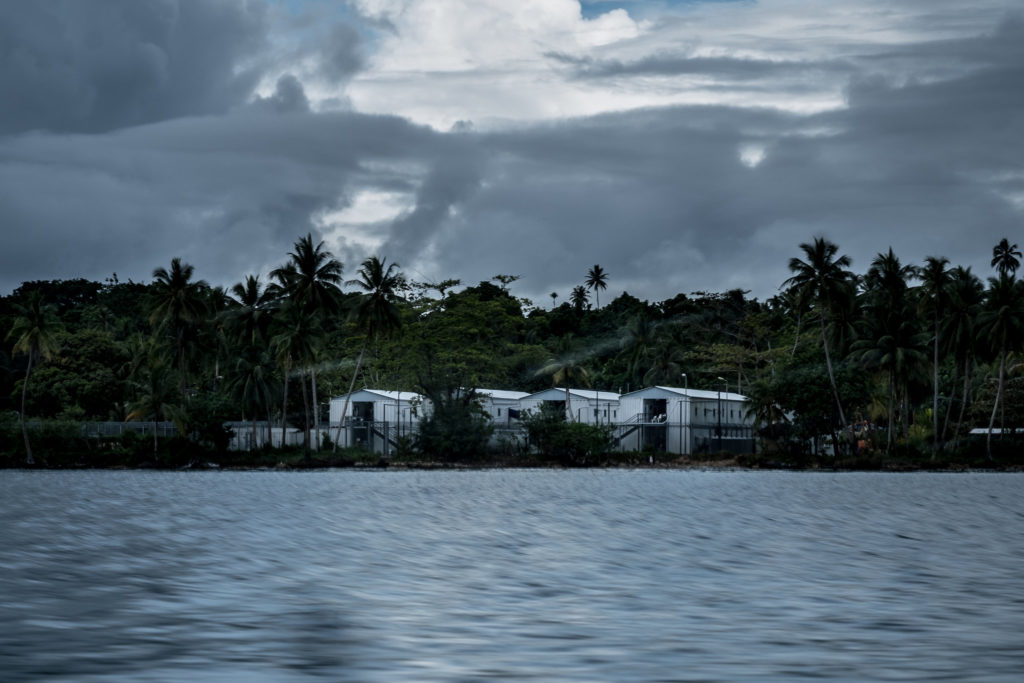
One of the compounds of the Offshore Processing Center on Manus Island. Credit Ashley Gilbertson/VII for The New York Times
The toll among Burmese, Sudanese, Somali, Lebanese, Pakistani, Iraqi, Afghan, Syrian, Iranian and other migrants is devastating: self-immolation, overdoses, death from septicemia as a result of medical negligence, sexual abuse and rampant despair. A recent United Nations High Commissioner for Refugees report by three medical experts found that 88 percent of the 181 asylum seekers and refugees examined on Manus were suffering from depressive disorders, including, in some cases, psychosis.
The world’s refugee crisis, with its 65 million people on the move, more than at any time since 1945, knows no more sustained, sinister or surreal exercise in cruelty than the South Pacific quasi-prisons Australia has established for its trickle of the migrant flood.
Australia, like Europe but on a much smaller scale, faces a genuine dilemma: What to do about desperate migrants trying by any means to gain asylum? Their journeys across the world have fueled rightist movements in many developed societies. Anxiety, whether related to jobs or terrorism, is high and, as Donald Trump demonstrated, scapegoating is effective. Approaches to the crisis have varied. Angela Merkel, the German chancellor, has taken in more than a million. But the Australian government argues that toughness is the only way to prevent the country from being overwhelmed.
It has “stopped the boats” and the Indonesian smugglers behind them: This is the essence of Australia’s case. The government says it has prevented deaths like those in the Mediterranean, where more than 4,000 migrants have drowned this year. By turning back the “queue jumpers,” a phrase that resonates in a nation devoted to a “fair go” for all, it has safeguarded Australia’s right to select who gets to people a vast and empty country. The official vow that those marooned on Manus and Nauru will never live in Australia has assumed doctrinal vehemence.
In Peter Dutton, the immigration minister, the country has its own little Trump. Last May he portrayed the asylum seekers as illiterates bent on stealing Australian jobs, and he has suggested “mistakes” were made in letting in too many Lebanese Muslim immigrants. His soft bigotry resonates with enough voters to sway elections.
At the same time, Manus and Nauru are a growing embarrassment to Australia, a party to all major human rights treaties. “There is an increasing realization that this is unsustainable,” Madeline Gleeson, an Australian human rights lawyer, told me.
Prime Minister Malcolm Turnbull knows this and needs a way out. After Omid Masoumali, a young Iranian, burned himself to death on Nauru this year, a cartoon by Cathy Wilcox captured Australia’s shame. Above a man in flames was the caption “Not drowning.”
The result is a one-time agreement with the United States, announced last month. America will, over an unspecified period, take in an unspecified number of the refugees, with priority going to the women, children and families who are on Nauru. The single men on Manus would presumably bring up the rear, if accepted at all with Trump in office.
Turnbull has said he’s confident Trump will not torpedo the deal. But when I asked Benham Satah if he thought he would soon be in the United States, he drew on a cigarette and gazed out to sea: “After three years suffering here I know only this: Unless you see it, don’t believe it.”
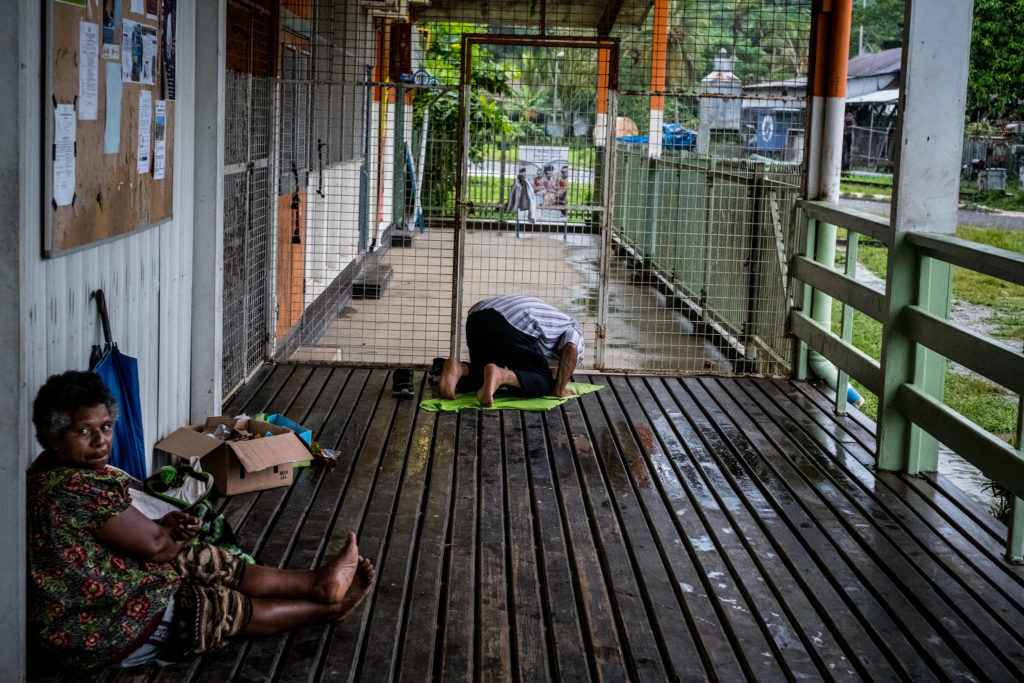
An Iranian refugee praying outside a store in Lorengau, Manus Island. Credit Ashley Gilbertson/VII for The New York Times
In the early morning at the Lorengau covered market, another Australian-funded project, women lay out produce and wares. Pickings are slim: pineapples, papaya and small bunches of peanuts. Giant turtles with prices scrawled on their bellies flap in expiration as the sun rises and flies hover.
Betel nut has pride of place on many tables. Chewing the nut is a Manus habit often manifested in scarlet lips and rotting teeth. Betel, a mild stimulant, prompts what June Polomon, who works in the market, called “our tendency to be nonstop chatterers, just like our noisy friarbirds.”
Visiting Manus in 1928, Margaret Mead, the American anthropologist, described a scene little changed nine decades later: “He puts a betel nut in his mouth, leisurely rolls a pepper leaf into a long funnel, bites off the end, and dipping the spatula into the powdered lime, adds a bit of lime to the mixture he is already chewing vigorously.”
As they chew, the people of Manus discuss property (familial attachment to land is fierce), daughters’ dowries and the many hundreds of asylum seekers who — unexpected and unexplained — were deposited in 2013 at the island’s Lombrum naval base, originally established by United States forces in 1944 under Gen. Douglas MacArthur.
“If Australia had cared, it would have told us something, talked to our village leaders, who are important,” Polomon told me. “We’ve been used in a neocolonial way.”
That is also the view of Charlie Benjamin, the Manus governor, whom I found in indignant mood. “It’s just morally wrong to dump these people here and then say, ‘Never Australia,’ ” he said. “Our understanding was we’d help a process and genuine refugees would move on, but no process exists.” He described endless wrangling with the Australian authorities over roads he believes they should pay for — the western half of the island is still so inaccessible the governor said it took him six hours to drive the 50 miles to his village.
Under the money-for-migrants deal between Canberra and the Papua New Guinea government in Port Moresby, Australia promised its former colony hundreds of millions of dollars, but chiefly for projects outside Manus. The 60,000 inhabitants of Manus were never consulted. Nor, of course, were the asylum seekers and refugees. When they arrived, they had no idea where they were. Seeing black Papuans, many thought they were in Africa. For almost three years they were held in the detention camp, humiliated and intermittently terrorized.
Last April, the Papua New Guinea Supreme Court ordered an end to “the unconstitutional and illegal detention of the asylum seekers or transferees at the relocation center on Manus”; it was an offense “against their rights and freedoms.” To which Dutton, the immigration minister, promptly responded that nobody in Manus “will settle in Australia.”
The only change resulting from the ruling is that refugees can now leave the camp during the day and take buses into Lorengau.
“We’re just in a bigger prison,” Abdirahman Ahmed, a Somali refugee, told me. The Shabab jihadi militia killed his father and brother in Mogadishu. “Sometimes I think maybe if I die it’s better. If you die there’s no question in front of you, no interpreter between you and God, no immigration, no Australia. We are not human, just a signpost: If you want to come to Australia you will end up in Manus with three years of trauma and torture.”
“The Australians argue about us and two elections were won fighting about our situation. ‘Don’t let in the boat people,’ they say, or ‘say yes to the boat people,’ but in the end, we’re just tools. No one really cares about us.”
— Abdul Aziz Muhamat
They are the walking dead, suspended in a dreamland, staring out at shimmering islets. Abdul Aziz Muhamat’s lips are trembling. He is from Darfur and recalls how Sudanese government forces bound a villager’s limbs to four horses “and they tore him up.” The soldiers put children in a fuel-doused hut and torched it. “I can see it like yesterday,” he says.
With an uncle’s help Aziz — the name he now uses — fled: Khartoum airport, Yemenia Airways Flight 632 (“I still remember the number”) to Sana, on to Dubai, and from there to Jakarta. He is met by a Sudanese man who whisks him south to Bogor, where he hides in a house with Iranians, Pakistanis, Burmese and others. It is mid-August 2013.
They move on by truck at night, then paddle in canoes to an island, and board a rickety boat crammed with 50 people. “I asked where we were going,” Aziz tells me, “and this guy said Australia.” But after 12 hours at sea, with the boat foundering, they turn back. Five people drown.
When Aziz tries again in October, his boat is intercepted by the Australian Navy and he is thrown into a detention center on Christmas Island with more than 40 others. Finally an Australian immigration officer tells them they will be flown to Manus, “a very dangerous place full of contagious diseases — if you touch a local, sanitize yourself.”
“I have a question,” Aziz says.
“That’s it. I cannot answer questions,” says the immigration officer.
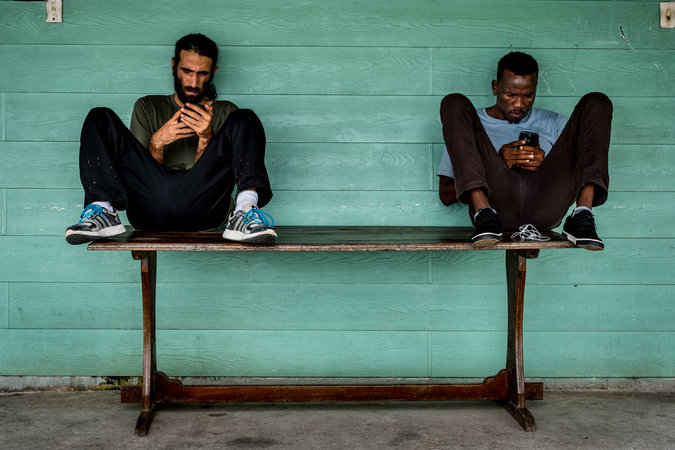
Abdul Aziz Muhamat, right, and Behrouz Boochani, a refugee from Iran. “We are here because of all Australia, all the people who are silent, who have done nothing,” Mr. Boochani said. Credit Ashley Gilbertson/VII for The New York Times
“If you know these things exist on Manus Island, why do you want to send us there?”
Aziz says he’s in a cage. The whole island is a cage. Then he says he’s in a hole. He has no feelings, no desire. There’s no point asking why. It’s been too long. At first conditions in the detention center are primitive, hundreds of men crammed into makeshift compounds or tents, scant food, bullying expat staff contracted by Australia, constant threats from a special Papuan police riot squad flown in at Australian expense — and no information, no “process.” Nothing.
Frustration boils up in early 2014. For weeks, there are peaceful protests every evening, chants of “Freedom.” But they have no effect, and the asylum seekers are told that “processing” could take a decade: Kafka in the tropics. Anger turns to rage. Two Iranians try to escape and are beaten up. Local thugs with machetes and bush knives, drunk on moonshine, goaded and abetted by some international security staff, pile into the camp. Shots are fired. Reza Barati is killed. Aziz, his toe broken, finds himself in the clinic among “170 guys lying on concrete, some conscious, some unconscious, bodies full of blood. I thought I was back in Darfur.”
Dump men in the middle of nowhere, confine them, abuse them, suspend them in limbo, and this is what you get.
The riot changes nothing.
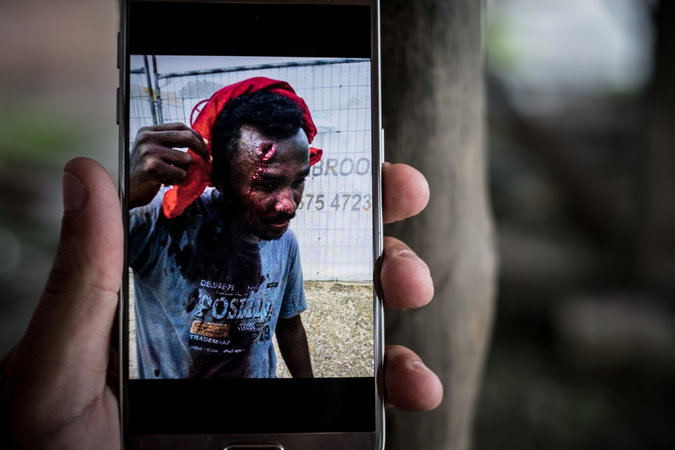
A man injured by a drunken mob, seen in a photo on another refugee’s phone. Credit Ashley Gilbertson/VII for The New York Times
A year later, in January 2015, hundreds of men begin a hunger strike. Several sew their mouths shut. The strike persists for two weeks. The authorities break it by throwing Aziz, Benham Satah and others into solitary confinement in windowless containers known as the “chauka” (named after a bird unique to Manus).
The hunger strike changes nothing.
Australia has relied on the remoteness and secrecy of its program: out of sight, out of mind. Keep the press out. Impose draconian nondisclosure clauses in contracts for everyone who works there. Even pass a federal law that can send whistle-blowers to prison. On the whole, it has worked.
Still, the ugliness is beginning to seep out. In 41 months these stranded men have had only two pieces of good news: the Papua New Guinea Supreme Court ruling and now the Australian deal with the United States.
“The deal represents a long overdue concession from the government that it cannot leave people on Manus and Nauru forever,” Daniel Webb, a lawyer at the Melbourne Human Rights Law Center, told me. “That concession is way overdue, but it does not end their suffering.”
“In most prisons they give you a time limit, and they respect at least some of your rights. Here they treat you as though you’re worse than a criminal or an animal.”
— Amin Abofetileh, who fled religious persecution in Iran.
Aziz, a smart young man who now has dreams of becoming a human rights lawyer, said the policy is “not about stopping boats. I think it’s about using innocent people as political tools to win elections.”
Moving the asylum seekers elsewhere to be processed was not in itself unlawful, so long as the process was fair and efficient and met basic human rights standards. There should have been explanatory sessions with the local authorities, clarity over who was running facilities, zero detention and an Australian-led regional effort to secure a decent life for the refugees. None of this occurred.
Instead, Australia, briefly under a Labor Party government and then under the conservatives, has effectively argued that the end (discouraging human smuggling) justifies the means (cruelty). As Hugh Mackay, a social researcher, observed, this is “the very same principle used to justify torture.” And even so, boats are still being turned around by a huge naval deployment.
A strange hysteria about the “boat people” seems to have blinded Australia to what is being perpetrated in its name. The country was founded on a similar principle to “offshore processing”: Britain’s dispatch in the late 18th century of convicts to a faraway land in Oceania, where they, too, would be invisible.
Its subsequent history has included the slaughter and incarceration of the native Aboriginal people; the White Australia policy, under which a vast land mass was seen as threatened by black people and other nonwhites emanating from places like Papua New Guinea; the “stolen generation” policy, under which tens of thousands of Aboriginal children were taken from their families and placed in white homes; and now this disgraceful consignment of asylum seekers, many of them dark-skinned and Muslim, to faraway islands where they are left to fester with the “natives.”
“Australians have a tendency to feel vulnerable,” Amelia Lester, the editor of the magazine Good Weekend, told me. “We’re so far from anywhere, it breeds a kind of paranoia.”
“In the beginning, I thought I was lucky to survive, to leave it all behind. I don’t feel that way anymore.”
— Hassaballa Hassaballa, a welder from northern Darfur in Sudan, who has been held for more than three years.
Just 24 million people live in Australia, a country twice the size of India, where 1.25 billion live. Might there be room to squeeze in 2,000 more? Australia has not known a recession in a quarter-century. Perhaps it is hard to imagine what humiliation and despair are. But it is time to imagine; they are right here, across the water.
“Whatever the policy challenge, deliberate cruelty to thousands of innocent people is never the solution,” Webb told me.
One measure of the government’s obsession is that it has introduced legislation to impose a lifetime ban from Australia for anyone held at one of the camps. So in theory, a man from Manus could go to the United States under the recently announced deal, become a Harvard professor, and never be able to visit Sydney.
Another is that it insists that the roughly 370 people moved from Manus or Nauru to Australia as “transitory persons” because they were injured in riots, or sexually assaulted, or were dying, or pregnant, or had broken down (like the wife of the Iranian who self-immolated) cannot stay in Australia. If they want to be considered for the American deal, they would have to return to one of the islands to be “processed.” The “transitory persons” include about 40 children. This is madness.
Lynne Elworthy, a mental health nurse, is one Australian who knows the agony of Manus and Nauru. She’s worked on both islands, and spoke to me in brave defiance of the nondisclosure rules meant to gag her. “Some cope better, focus on gym and seem to do O.K.,” she said. “But many men in Manus are withdrawn, skinny, depressed and worn out, hopeless, with plummeting lows. It’s quite obvious to see this. They exist in a lifeless pit.”
She continued: “Apart from the way the whites treated the Aborigines when they first arrived — that was worse — this will come in second by the time Manus and Nauru are considered for their absolute cruelty. I imagine one day a royal commission will look into the illegal imprisonment, the damage caused, the agony and the injury.”
“I am a free man. I am with the birds and the ocean. I am outside of the system. I am free.”
— Behrouz Boochani, who in April climbed a tree in the detention center to avoid being forcibly removed from the compound and permanently resettled in Papua New Guinea.
On my last day in Manus I managed to get through the navy checkpoint at the entrance to the camp. Rain was falling heavily. I drove past General MacArthur’s old house, and an American-built church, and down to the high metal fences and barbed wire. Dozens of Australian border guards were exercising in a field. Jeeps and white S.U.V.s splashed by. I saw the barracks — Oscar and Delta and Mike and Foxtrot — and by now it was easy to imagine the suffering endured within.
Behrouz Boochani, another Iranian refugee, had broken down in front of me a couple of days earlier, crying uncontrollably. “I can’t sleep,” he said. “I want justice,” he said. “I have one million pages of incriminating documents,” he said. Emaciated, with pale green eyes, a ponytail and beard, he was a broken but still determined man: “We are here because of all Australia, all the people who are silent, who have done nothing.”
Among the refugees is Nayser Ahmed, a Rohingya who fled persecution in Myanmar on July 2, 2013. Now 63, he made his way to Indonesia with his wife and six children. But when they boarded the bus to go to the boat, he was unable to squeeze in alongside. His family reached Australia before the imposition of the Manus and Nauru policy, and now live in Sydney. He did not. Every effort to be reunited with his family since he arrived in Manus on Nov. 15, 2013, has failed.
“I was shouting and screaming, ‘My family is gone, someone help me!’ But no-one came. That is my only regret. When I close my eyes, I can see that bus leaving.”
– Nayser Ahmed
Ahmed’s nose and ribs were broken in the 2014 riot. A daughter got married in Sydney two years ago; he told her to stay well and not think too much. He blames himself for missing the bus.
“I think all the time about what happened,” he told me. “At night I close my eyes and see the bus leaving. I can feel it. I was shouting, I was screaming, ‘Somebody help me!’ ”
What is incumbent on Australia now is clear enough. Prevail on Trump to take as many of the refugees as possible. Reunite Nayser Ahmed with his family. Recognize that the country has incurred a moral debt to the myriad people it has mistreated on the islands and allow those who do not go to the United States to build a decent life in Australia. Make the “transitory persons” already in Australia permanent residents. Close this foul chapter that stains Australia and echoes the darkest moments in its history.
Aziz had been reading Mandela’s biography. One of these men, allowed a chance, might yet make Australia proud.
________________________________________
Roger Cohen – international affairs and diplomacy.
DISCLAIMER: The statements, views and opinions expressed in pieces republished here are solely those of the authors and do not necessarily represent those of TMS. In accordance with title 17 U.S.C. section 107, this material is distributed without profit to those who have expressed a prior interest in receiving the included information for research and educational purposes. TMS has no affiliation whatsoever with the originator of this article nor is TMS endorsed or sponsored by the originator. “GO TO ORIGINAL” links are provided as a convenience to our readers and allow for verification of authenticity. However, as originating pages are often updated by their originating host sites, the versions posted may not match the versions our readers view when clicking the “GO TO ORIGINAL” links. This site contains copyrighted material the use of which has not always been specifically authorized by the copyright owner. We are making such material available in our efforts to advance understanding of environmental, political, human rights, economic, democracy, scientific, and social justice issues, etc. We believe this constitutes a ‘fair use’ of any such copyrighted material as provided for in section 107 of the US Copyright Law. In accordance with Title 17 U.S.C. Section 107, the material on this site is distributed without profit to those who have expressed a prior interest in receiving the included information for research and educational purposes. For more information go to: http://www.law.cornell.edu/uscode/17/107.shtml. If you wish to use copyrighted material from this site for purposes of your own that go beyond ‘fair use’, you must obtain permission from the copyright owner.
